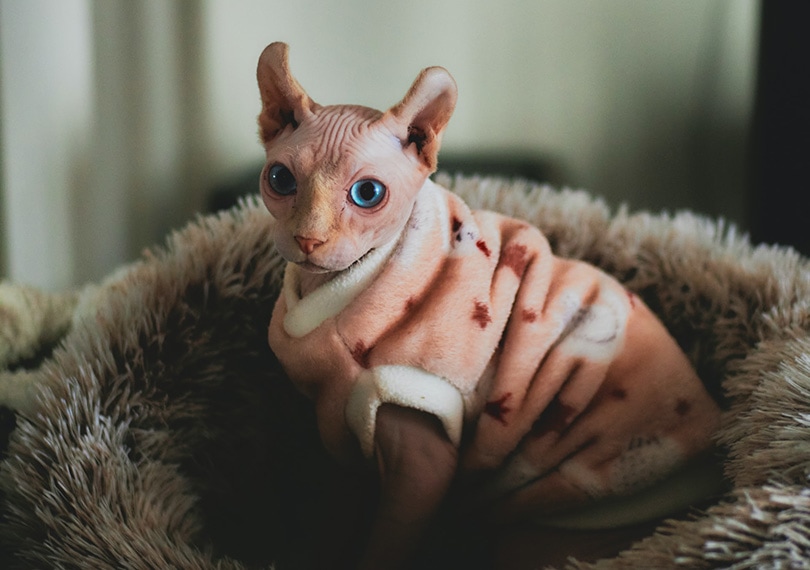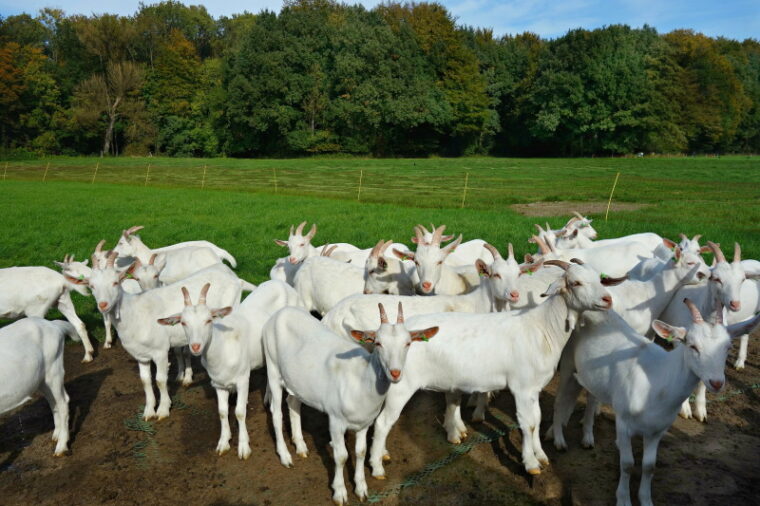
Note: This article’s statistics come from third-party sources and do not represent the opinions of this website.
Humans have used domesticated goats for hundreds of years. These adaptable, versatile animals have many uses in the livestock industry including meat, dairy, fiber, and companionship.
While Australia uses goats for all of these purposes, they have also encountered a problem over the years with feral goats establishing their own wild population after either escaping or being set free from their farms.
In this article, we’ll go over all things goat in the Land Down Under. We’ll talk about their introduction, numbers, and statistics within the livestock industry and how they contribute to agriculture while also being a problematic invasive species.
- Australia’s Feral Goat Population
- Goat Meat Production in Australia
- Dairy Goats in Australia
- Goat Fiber Production in Australia
The Top 20 Australian Goat Statistics
- Australia has about 2.3 million feral goats
- There are about 1 billion goats globally
- 80% of Australia’s feral goats produce cashmere
- Goats were first brought to Australia by the First Fleet in 1788
- The goat population in Australia can double every 1.6 years
- The feral goat is a category 3, 4, and 6 restricted invasive animal
- Australia is the world’s largest exporter of goat meat
- There were 1,019,741 goats supplied for processing across Australia in 2021
- New South Wales supplied 67% of the goats processed nationally in the 2020/21 financial year
- Victoria is the largest processor of goat meat
- Australian exporters shipped 15,713 tonnes of goat meat to 16 countries
- There are six recognized dairy goat breeds in Australia
- Dairy goats are farmed in all states
- Dairy goat lactation lasts approximately 300 days
- A herd size of approximately 300 goats is needed for commercial dairy production
- There are two primary fiber goat breeds in Australia
- Mohair and cashmere are the two fabrics created from goat hair
- Purebred cashmere goats yield about 300 grams of cashmere per year
- Australia contributes to only 5% of the world’s mohair production
- The mohair-producing Angora breed was first introduced into Australia in the 1830s

Australia’s Feral Goat Population
1. Australia has about 2.3 million feral goats.
(Queensland Government)
Goats are native to Europe, Asia, and Africa, and have been domesticated for thousands of years. Australia currently has an estimated 2.3 million feral goats that had initially either escaped or were released, establishing a wild population. The largest numbers of feral goats exist in the semi-arid pastoral areas of Western Australia.

2. There are about 1 billion goats globally.
(Frontiers in Veterinary Science)
Goats are a very versatile type of livestock that are inexpensive and easy to keep. They provide meat, dairy, fiber, and even companionship to other livestock. These uses make them not just convenient for farmers, but also very profitable.
Thanks to the popularity of goats growing over the years, there is now an estimated population of 1 billion goats across the globe, which has more than doubled over the last four decades.
3. 80% of Australia’s feral goats produce cashmere.
(Queensland Government)
Most of Australia’s feral goat population also referred to as rangeland goats, are descended from the Cashmere and Angora breeds, which are the two fiber-producing breeds. 80% of these feral goats are used to produce cashmere alone.
Control of these feral goat populations is most often influenced by the market but keeping their numbers managed is essential for conservation and agricultural benefit.
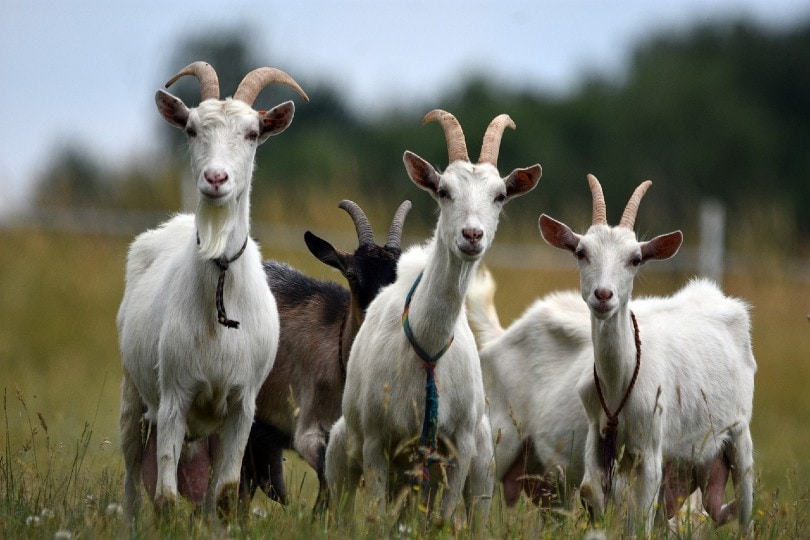
4. Goats were first brought to Australia by the First Fleet in 1788.
(Queensland Government)
The First Fleet consisted of eleven ships made up of two Royal Navy vessels, three store ships, and six convict transport ships. This fleet brought the first European and African settlers to Australia. Goats made their way to the Land Down Under by way of the First Fleet in 1788.
5. The goat population in Australia can double every 1.6 years.
(Queensland Government)
Australia’s goat population can double every 1.6 years if no control methods are put in place. To prevent this from happening, at least 35% of the population must be removed every year. Control methods include mustering, shooting, and trapping. The rangeland goats make up about 90% of the goat meat production of the country.
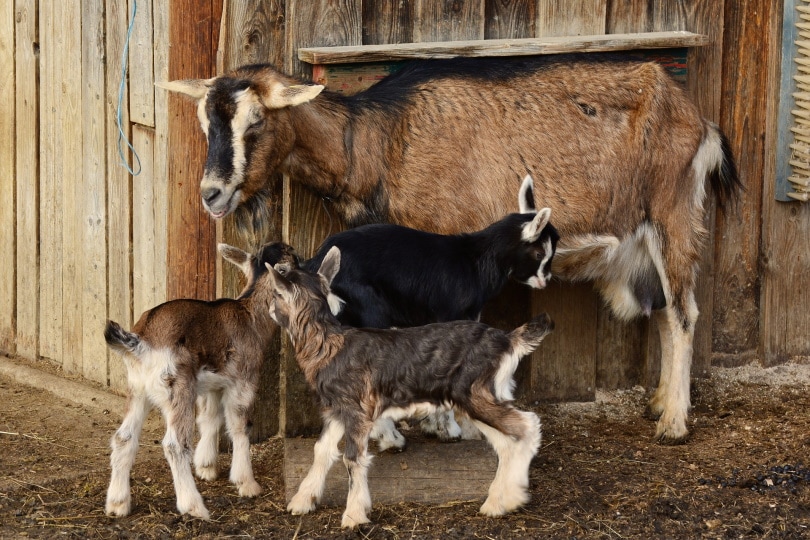
6. The feral goat is a category 3, 4, and 6 restricted invasive animals.
(Queensland Government)
Feral goats were placed in categories 3, 4, and 6 as restricted invasive animals. They compete for pasture, cause damage to fences and property, and cause a reduction in profits for the agricultural industries. They also overgraze the land, leading to soil erosion, land degradation, and reduced plant diversity.
Goat Meat Production in Australia
7. Australia is the world’s largest exporter of goat meat.
(Goat Industry Council of Australia)
While Australia is a relatively small producer of goat meat, they are the world’s largest exporter. Rangeland goats and Boer goats are the two main breeds used in the goat meat industry, though any purebred or cross-breed is suitable.

8. There were 1,019,741 goats supplied for processing across Australia in 2021.
(NSW Government)
During the 2020/2021 financial year, there were 1,019,741 goats supplied for processing across all states in Australia. That is a 30% decrease from the previous year. Each state saw a decline in the number of goats processed.
9. New South Wales supplied 67% of the goats processed nationally in the 2020/2021 financial year.
(NSW Government)
New South Wales supplied 67% of the goats processed during the 2020/2021 financial year at 686,569 head, a 34% decrease compared to the previous year. Queensland was the second largest producer, with 219,563 head, an 11% decrease.

10. Victoria is the largest processor of goat meat.
(NSW Government)
Victoria may supply the smallest number of goats for processing, but they are the largest processor of goat meat in Australia. The state slaughtered more than half the national total in the 2020/2021 financial year.
11. Australian exporters shipped 15,713 tonnes of goat meat to 16 countries.
(NSW Government)
The United States is the largest and most significant importer of Australian goat meat, making up 64% of the export volume for the country. Japan, Taiwan, South Korea, Canada, and Trinidad & Tobago are also consistent importers.

Dairy Goats in Australia
12. There are six recognized dairy goat breeds in Australia.
(Goat Industry Council of Australia)
Australia has six recognized breeds of goat used for dairy production in the country including Anglo Nubian, Sanann, British Alpine, Toggenburg, Australian Brown, and Australian Melaan. Goat milk makes a great alternative to cow’s milk, especially for those that suffer from lactose intolerance.
Goat milk has also been popularized as gourmet milk, cheese, and yogurt is used in fine dining. It is also commonly used in natural soaps, moisturizers, and other body care products.
13. Dairy goats are farmed in all states.
(Goat Industry Council of Australia)
The Australian dairy goat industry is very geographically diverse, with dairy goats being farmed in every state. There is an increasing demand for goat milk for use in exotic cheeses and as an alternative to cow’s milk. Australia’s dairy goat industry also serves as a high-quality export market for stud dairy goats.
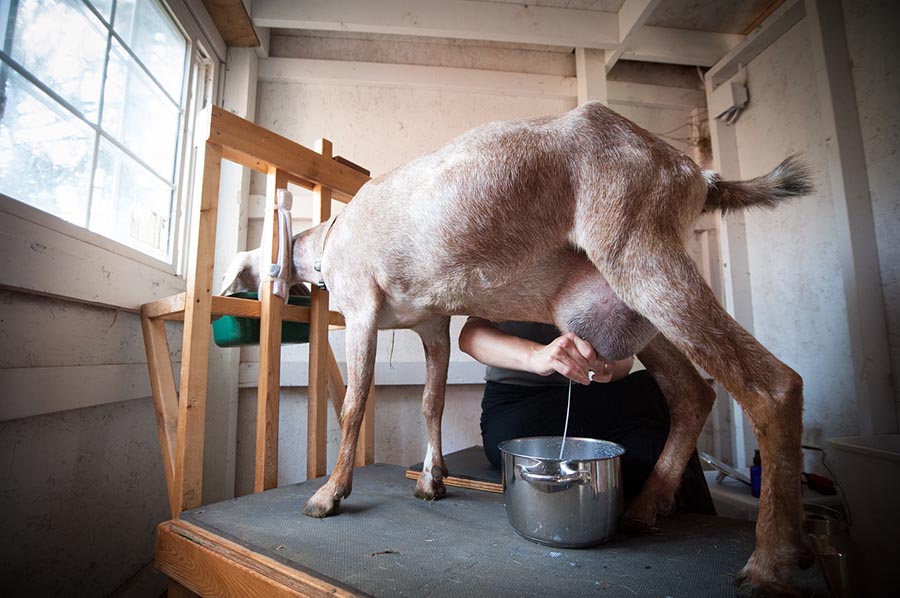
14. Dairy goat lactation lasts approximately 300 days.
(Goat Industry Council of Australia)
Goat milk is obtained through traditional breeding practices. The kid is removed from the mother at birth and bottle-fed. The mother’s lactation lasts approximately 300 days and each doe will yield around 2 to 3 liters of milk per day and up to 4 liters per day during peak lactation.
15. A herd size of approximately 300 goats is needed for commercial dairy production.
(RSPCA)
To meet commercial demand and have a successful commercial dairy operation with goats, a farmer must aim to have a herd of around 300 goats or more. Victoria currently makes up over one-third of the country’s dairy production in Australia.

Goat Fiber Production in Australia
16. There are two primary fiber goat breeds in Australia.
(Goat Industry Council of Australia)
The Angora and the Cashmere are the two breeds that are involved in fiber production within the country. Most of the rangeland goats were descended from the Angora breed but are much more common in the meat industry. Farmers invest heavily in purchasing the most high-quality genetics within these breeds to meet market demand.
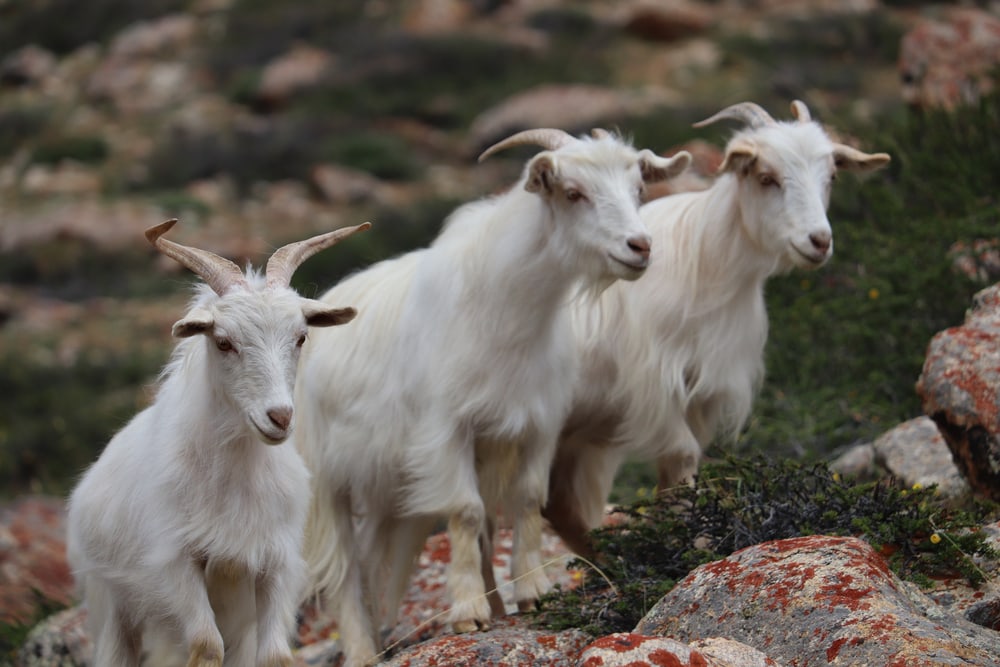
17. Mohair and cashmere are the two fabrics created from goat hair.
(Goat Industry Council of Australia)
Mohair is the long, smooth, lustrous fiber that is used in sweaters, hats, and a variety of other products. This fiber comes from the Angora, while cashmere comes from the Cashmere breed. Cashmere is considered one of the world’s most premium fabrics and has been used in yarn, clothing, and textiles for hundreds of years.
18. Purebred cashmere goats yield about 300 gms of cashmere per year.
(Goat Industry Council of Australia)
Cashmere comes from the fine, downy undercoat of the Cashmere breed. The coarse guard hair on the outside has no commercial value. Cashmere goats will typically yield about 300 gms of cashmere per year and the current demand outweighs the supply, giving way for opportunity within the industry.

19. Australia contributes to only 5% of the world’s mohair production.
(Science Direct- Preventative Veterinary Medicine)
South Africa is the largest producer of mohair in the world, accounting for about 60% of global production. The United States is also a top global supplier. Australia only contributes to 5% of the world’s mohair production.
20. The mohair-producing Angora breed was first introduced into Australia in the 1830s.
(Goat Industry Council of Australia)
The Angora breed was first introduced into Australia from France in the 1830s. The mohair industry saw a steep decline in the country in the late 1980s and 1990s but has since been recovering. It was the Cashmere breed that was introduced on the First Fleet in 1788. Both breeds contribute heavily to the rangeland population.
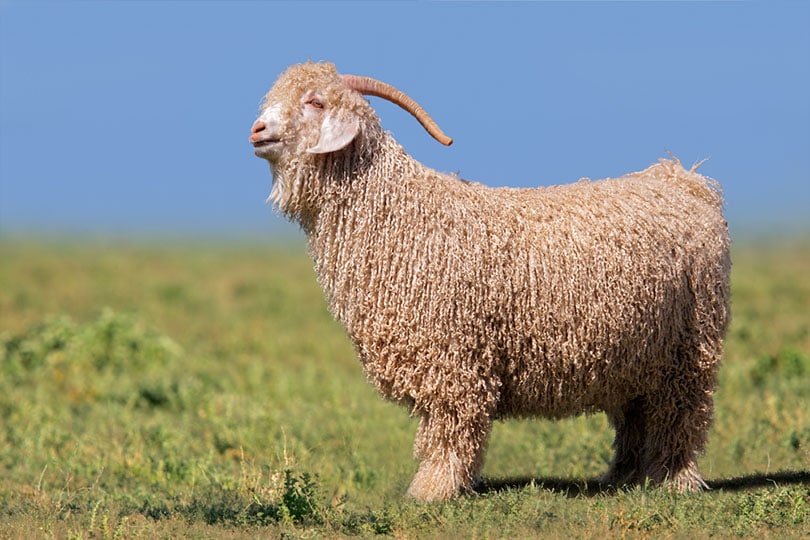
Frequently Asked Questions About Goats in Australia
What impacts do rangeland goats have on the environment?
Australia’s rangeland goats are very hardy and adaptable. They have learned to thrive in very dry environments and across rugged terrain. They cause a significant amount of environmental damage by competing for pasture with livestock, damaging fences, and reducing plant diversity because of their specific diet. This impact not only affects agricultural productivity but also affects both domestic and native animal species.
Do Australia’s rangeland goats have any natural enemies?
Yes, the feral rangeland goats do have natural enemies. Both dingoes and wild dogs will prey on these goats, though they have adapted to areas that offer natural protection against these predators.
Are there any laws in place to help control the number of feral goats?
Yes, individuals must not give away, sell, or release feral goats into the environment. Doing so could result in a penalty. They must also take all reasonable and practical measures to minimize the biosecurity risks associated with dealing with feral goats under their control. Local councils must have a biosecurity plan that covers invasive plants and animals in the area, including feral goats. In some areas, these actions may be required under local law.

Is goat meat healthy?
Goat meat is considered a very healthy alternative and is nutritionally superior to other forms of meat. It is lean, low in both fat and saturated fat, and rich in iron. It also offers the same amount of protein when compared to beef, chicken, pork, and lamb and is a great source of vitamin B12, zinc, and potassium.
How popular is goat milk?
According to the Goat Industry Council of Australia, more people drink goat milk compared to any other animal worldwide. Goat milk is more easily digestible than cow’s milk and is a great alternative for those that are allergic to cow’s milk. Goat milk is used for cooking, baking, and drinking. It is also used to make cheese, butter, yogurt, candies, soaps, and moisturizers.
Conclusion
Not only are goats used for meat, dairy, and fiber but Australia also struggles with invasive rangeland goats. Also referred to as Australian bush goats, these feral animals are impacting the environment and the local agriculture industry. The country must control the population to keep it from getting even further out of control. For this reason, they make up a large portion of the Australian goat meat industry.
Featured Image Credit: Mabel Amber, Pixabay





